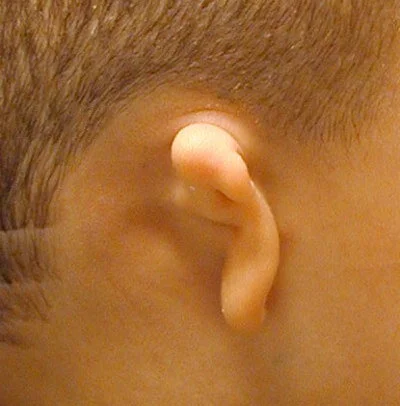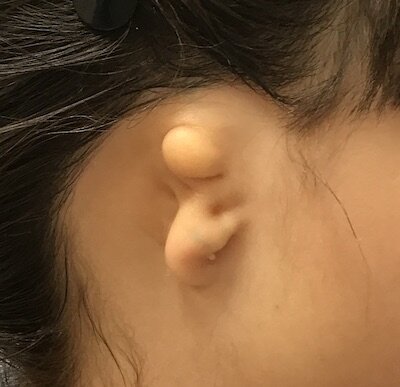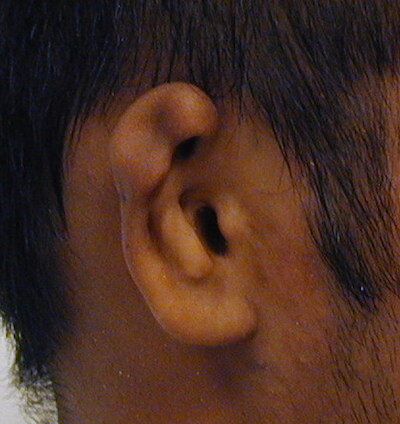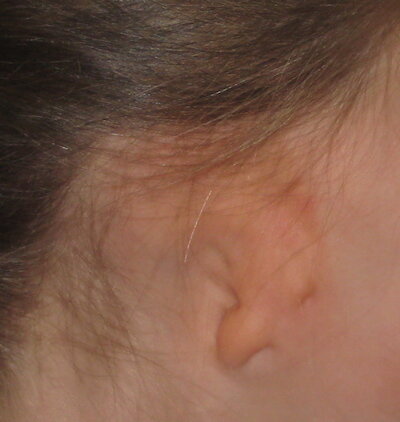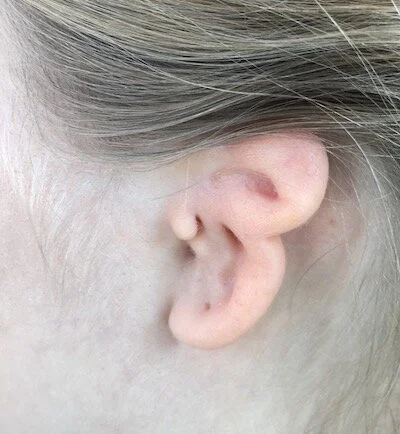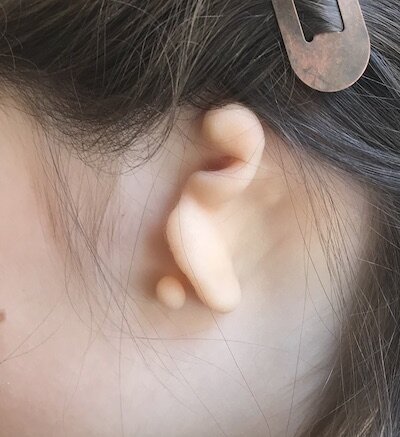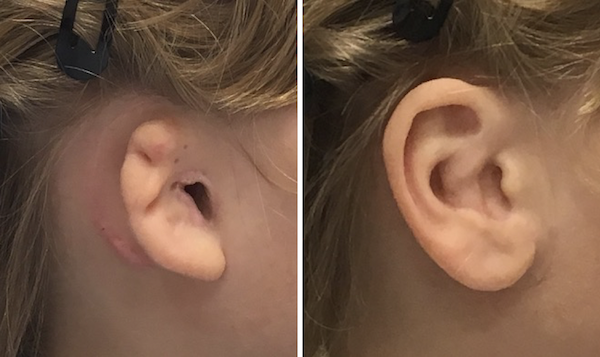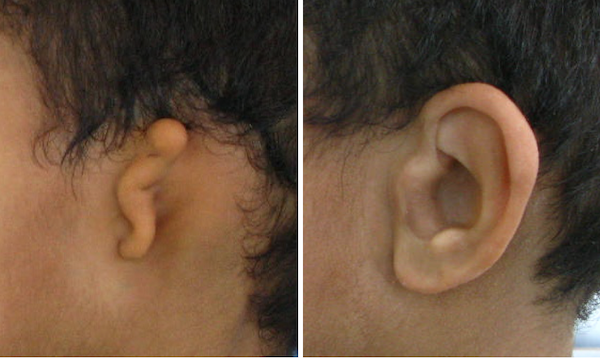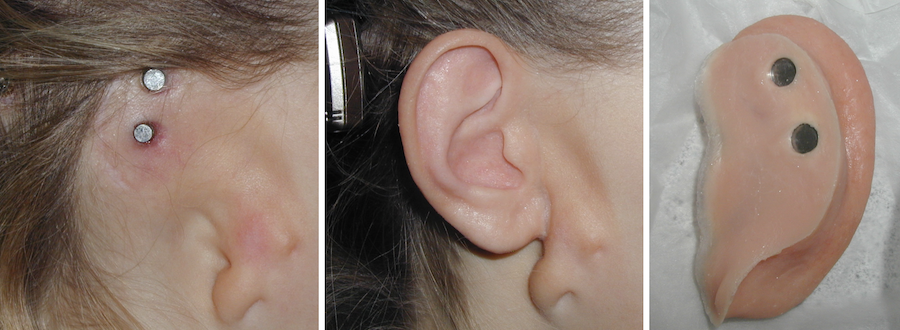Prosthetic Ear Over Microtia: A Treatment Option
What is microtia?
Microtia is a condition that is present at birth in which the external ear is underdeveloped. Microtia may affect one or both ears, but it most commonly occurs on the right side. It is sometimes related to craniofacial syndromes such as Treacher Collins or Goldenhar. Microtia is often accompanied by atresia, or absence of the ear canal. When the ear canal is absent, there is usually conductive hearing loss on the affected side(s). The little ear is often located a little more forward and slightly lower than a “normal” ear. As you can see, the shape, size, and placement of the little ear vary from one person to another:
Prosthetic ear over microtia: a treatment option
We see many children and adults with microtia and atresia in our office who are interested in prosthetic restoration of the external ear. While some patients who wear a prosthesis opt to have their underdeveloped ear removed as part of their prosthetic treatment plan, others choose to keep the little ear in place. Preserving the little ear means saving skin and cartilage that might be useful for future surgical reconstruction or other reconstructive options that may emerge as technology advances. A prosthesis that fits over the little ear provides an opportunity to see what it’s like to have a more fully formed big ear without surgical intervention. For some families, an ear prosthesis acts as a temporary treatment solution until a child is old enough to decide for himself how he’d like to proceed with treatment of the microtia, if at all. However, a prosthesis over microtia is a treatment option at any age.
When the microtia is preserved, the prosthesis is designed to fit over the little ear like a glove. During a sculpting appointment, we determine appropriate placement of the prosthesis by observing anatomical landmarks, taking facial measurements, and finding a symmetrical position in relation to the other ear when possible. No two ears are the same, and every prosthesis is custom-made for each patient.
There will almost always be a compromise to the form of the prosthetic ear as it wraps over the underlying microtia – typically a raised area or bulge that doesn’t exist in a “normal” ear. The degree of compromise depends on the size and position of the little ear, and will vary from one patient to the next. Here are three examples that demonstrate the type of compromise that may occur when working over the underdeveloped ear:
In some cases, it may not be possible to work around the existing microtia and achieve an acceptable result. We are happy to meet with you and your family to discuss the prosthetic ear over microtia option for your particular situation.
ATTACHMENT OPTIONS FOR A PROSTHESIS OVER MICROTIA
1) Skin Adhesive
When the microtia is kept in place, the prosthesis can be designed to attach in two ways. One option is to use skin adhesive to secure the prosthesis in place over the little ear. This involves daily application of a gentle liquid adhesive onto the back surface of the prosthesis before pressing it into place. The prosthesis is then removed at the end of the day and the adhesive is cleaned from the prosthesis and the skin. No surgery is needed for an adhesive-retained prosthesis, and it can usually be completed in just three office visits. The three side-by-side photos above are examples of adhesive-retained prosthetic ears over microtia.
2) Craniofacial Bone-Anchored Implants
The second attachment option requires one or two relatively minor surgical procedures to have two or three craniofacial osseo-integrated implants placed just behind the little ear for attachment of the prosthesis. Small titanium implants are placed into the bone and allowed to heal for a period of 3-6 months. External components called abutments are then attached to the titanium fixtures and protrude through the skin for magnetic attachment of the prosthesis. Like an adhesive-retained prosthesis, an implant-retained prosthetic ear should also be removed at night for cleaning and to clean the underlying skin.
The patient below has two bone-anchored implants for magnetic attachment. On the back of the prosthesis, you can see the two magnets and the hollowed out area that fits snuggly around the little ear:
The patient in the next photos has a little ear that is especially far forward and low. The microtia remains outside of the margins of the prosthesis when it is positioned symmetrically to the other ear, so there is no compromise to the form of the ear:
Even when attachment is very secure, it is possible to dislodge an ear prosthesis during certain activities. An adhesive-retained ear may also loosen due to facial movement, perspiration or humidity. An implant-retained prosthesis provides the most reliable and secure retention, but is not perfect.
Making a decision…
There are many treatment options for microtia, as well as doing nothing at all and going natural. There is no right or wrong approach, as it’s a very individual decision. It can be overwhelming to choose which option is the best for you or your child, and we are very happy to provide as much information and support as possible to aid in the decision-making process. Please explore our website to learn more about prosthetic restoration of the ear, download or print our Microtia Reference Guide, or feel free to leave a comment or call us with questions or to schedule a complimentary initial consultation. We look forward to hearing from you!

